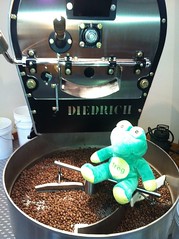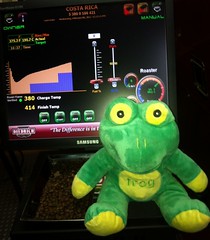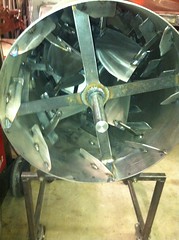An old post I am re-posting from our old blog. Originally posted Feb 2012. A compilation of notes about heat and roasting.
Forms of Heat Transfer
There are three forms of heat transfer:
- conduction,
- convection and
- radiation

Frog Quaffer in a cooling binThese are deceptively simple scientific concepts that underscore some of the more fractious debates within coffee roasting. In our current age, when scientific terms are often used and misused, to prove or disprove often diametrically opposed points of view, these three terms are at the heart of two of modern roasting’s most fundamental debates, one practical and the other very much philosophical.
Coffee Roaster‘s who gain a better understanding of each source of heat, will be able to use this knowledge to produce better more consistent roasts.
Conduction
Conduction is the transfer of heat from direct contact between the molecules of a hotter substance to a cooler one.
Say you were to accidentally touch the end of the trier to your nose while attempting to smell your coffee, and burn your nose, this would be the result of conducted heat: the hotter molecules of your trier directly transferring heat to the cooler molecules of your skin.
In drum roasters, there are three potential sources of conducted heat:
- the drum,
- the faceplate and
- the beans.
There are those who would argue that the metal of a cold and then hot cooling tray is also a potential conductor, but for this to occur the sides and/or bottom of the tray would need to be hotter than the coffee itself. And while warm cooling trays can lengthen cooling times, they should never be hot enough to conduct heat directly to the coffee.
The rate and ratio of conduction in a drum roaster is initially affected by drum preheat temperature and load mass. In most modern drum roasters, approximately 80 percent of the heat transference is via forced convection. In air roasters, the percentage is significantly higher.
Convection

Frog Quaffer with the roast profileConvection is the transfer of heat through currents in a liquid or gas.
In the case of coffee roasting, the transferring substance is air and the receiving substance is coffee. There are two major types of convection:
- natural convection and
- forced convection.
Natural convection occurs as our air heats up, causing density changes; as air grows hotter, it gets lighter and rises, while the denser, cooler air falls. This flow then allows heat to transfer through the natural movement of buoyancy.
Forced convection is heat transferred through currents that are moved by an outside force, such as a pump or fan. Forced convection is a quicker, more efficient method of heat transfer than natural convection.
In both drum and air roasters, forced convection is the major mode of heat transfer in the roasting process. Air roasters force air through the roasting chamber via positive pressure (blow), and drum roasters use negative pressure (suck). Either way, when roasting personnel discuss convection in the roasting process, it is forced convection to which they are referring.
The rate and ratio of convection in a drum roaster is directly affected by airflow and energy supplied by the burner. The higher the airflow and the higher the energy input from the burner, the faster the roast.
Radiation
infra-red burnerRadiated heat is thermal radiation that is defined as electromagnetic waves, and it occurs naturally between two bodies of differing temperatures.
It needs no carrying medium, unlike conduction and convection, and travels at the speed of light. A substance’s ability to accept and /or throw off radiated heat is affected by its colour, temperature, density, surface area, finish and geographical orientation to other thermal-producing bodies.
In the case of coffee roasting this is very difficult to measure or to control. For roaster operators, the important thing to remember about radiated heat is that it exists, period. You can neither measure it nor control it, so realize it’s there and then focus on the types of heat you can both measure and control.
There is, however, some confusion over radiant heat or infra-red burners in drum roaster applications (for example the Diedrich roasters). Even using infra-red burners, it is still the conduction of the drum and the beans, plus the forced convection of the air, that is of primary concern to the operator.
The rate and ratio of radiation in a roaster is an unknown, and needs to be considered. This is one reason my coffee profiles are an essential element to developing the ideal roast.
It Is About Total Energy

Inside a Dierich barrelThere are the three sources of heat over which a roaster has some level of control
- Drum, Air, Bean
- Air, Drum, Bean
- Bean, Drum, Air
The little mantra above represents the periods of the roast at which each type of heat is at its most influential.
At the beginning of the roast, the amount of stored energy in the drum-represented by drum or preheat temperature-is at its most important and potentially most damaging to the bean.
Air or convection is the dominant form of heat transfer throughout the roast, but air is also the all important driver for the body and flavour formation portion of the roast.
Toward the end of the roast, the coffee beans themselves become an important source of energy and can actually become the dominant way that heat is transferred in some roasts and / or roasters.
All of the above forms of energy play their part in the magic of converting the green coffee to roasted coffee. As a roaster, it is imperative to gain a better understanding of each source of heat, and then exercise that knowledge of each within your own equipment, to better control your roasting. This is what the concept of total energy is about.
Three important things to remember regarding total energy
- Coffee roasting is a dynamic process that changes throughout the course of the roast.
- There is infinitely more energy later in the process than earlier.
- None of the forms of heat transfer are independent of one another.
Strategies For Gaining Control of the Roast
Conduction (Drum / Faceplate to Bean)
It is a myth that a roaster has little or no control over drum to bean conduction. What is true is that the only true control over this type of heat transfer, is at the beginning of the roast. Once a roast has begun, there is little you can do to affect this type of heat transfer. But, at the beginning of the roast, there is plenty that you can do. Controlling drum to bean conduction is all about preheat (or charge) temperatures.
Roasters should set and follow preheat temperatures, especially in reference to the temperature of the bean at point of equilibrium (sometimes called “turning point”). Preheat temperatures represent stored energy. The higher the preheat temperature, the hotter the roaster, the more energy is stored in the drum and the faceplate, and the more energy can be transferred via conduction. By being consistent in your preheating, you will be starting every roast with approximately the same amount of stored energy, allowing you to roast in a more consistent manner.
A simple principle for partial batches is that, it is absolutely imperative that you lower your preheat temperatures if you wish to follow a similar profile as when you are roasting a full batch. Less coffee (as in mass). Partial batch preheat temperatures can easily be determined with a little experimentation; just take note of the lowest reading via your bean probe after the coffee is dropped into the drum. You want this point of equilibrium (or “turning point”) to be the same, or nearly the same, regardless of batch size.
If, when roasting partial batches, you see that the point of equilibrium is above that of a full batch, then lower your preheat temperature the next time you roast this size of batch. Eventually, you will be able to determine the correct preheat temperatures for the varying load size of your roaster. Remember this when roasting partial batches in drum roasters: It is always easier to add energy than to take it away once your roast has begun.
Symptoms of too much conductive heat (drum to bean)

Coffee Tip burnt or tipping
- Tipping (an uneven roast colour, with dark spots on the tips of the bean)
- Uneven roasting / too fast
- Mottled / scorched beans
Conduction (Bean to Bean)
Through the majority of the roast cycle, you have two sources of heat energy the drum and the air. Just before you hear first crack, you have a third source of energy–the coffee beans themselves.
A well-functioning cooling system is critical for gaining control of roast profiles.
As the coffee approaches first crack, it begins to go exothermic and throws off heat, hence the sound associated with the cracking of the bean. Sound is a form of energy, and the cracking of the bean signifies that energy is being released. If this energy is not accounted for in the overall energy equation, then the roaster risks losing control of the profile, or the roast. There are three strategies for taking control of the roast at this point: adjust the burner down or off, increase airflow, or both. In essence, you are manipulating the rate of convection in order to control the total energy and hence the profile of the roast.
Symptoms of too much heat at first crack (bean to bean)
- Uneven roasting / too fast
- Unusual amounts of smoke
- Moving almost immediately from first to second crack
As you approach the end of the roast, you must be aware of the possible consequences of bean energy once again. The faster and harder you approach the termination of the roast, the more kinetic energy will need to be dissipated by the cooler. In other words, the more aggressive your profile curve is at this point, the harder it will be to stop the roast at your desired termination temperature. This can become especially critical if you are operating in a building that is not climatically controlled (i.e. air-conditioned), in an area where there are significant swings in temperatures throughout the year. Additionally, the darker the roast, the more energy is available to push the coffee past your desired stopping point. This potential problem can be handled in the same manner as you deal with gaining control at first crack: adjust the burner down or off, adjust the airflow, or both. By “slowing down” or reducing heat at the end of your roast, you will gain more control and use less energy as well. Once again, you are manipulating the rate of convection to lessen the impact of the energy of the beans themselves.
Note: A well-functioning cooling system is critical for gaining control of roast profiles. Many a darker-roast coffee has been, and still is, being ruined by inadequate or ill-functioning cooling systems. Research possible fixes.
Convection

air flow control is importantConvection is the cornerstone of the roasting process for both drum and air roasters. It is the most dominant, the most easily understood, the most measurable and the most controllable. Once again, forced convection is heat carried by currents created by a fan or blower.
You can change the rate of convection by:
- changing the airflow,
- changing the energy output of the burner,
- or by a combination of the two.
Unlike all forms of conduction in the roasting process, it is possible to make adjustments in the rate of convection that can have near-immediate effects on your roast profile. Although you cannot truly read convection, you can begin to get a handle on its effects by reading the drum environment temperature along with a bean probe, or through the use of a real-time data-logger.
Convection is truly a modern roaster’s friend. A high rate of convection means coffee is roasted more evenly, more cleanly as most smoke and chaff is pulled away from the coffee, and each roast is more controllable and repeatable. The trick is finding the technique that works best for you in your installation, and your tastes.
Conclusion
There are three forms of heat energy; conduction, convection and radiation. The two “C”‘s can be controlled with effect with the modern roaster, the other you need to be aware of. These are manipulated by controlling the charge or dump temperature, the amount of energy you introduce to the coffee is controlled by the heat and the air flow, and how you cool in the cooling bin.
Convection is the most dominant and the most controllable form of heat transfer and, as such, it is the place to start in gaining better control. A roaster with an understanding of how heat affects the roast can create a more flavorful product in a more efficient and more consistent manner. This is truly the hallmark of a professional roaster.
Reference:
www.ambexroasters.com, their site has some great tips but thought this was worth reposting, with my own edits. This is also found here:The Heat Is On: A roaster’s guide to heat transfer by Terry Davis
So I am not sure which is the original source.



